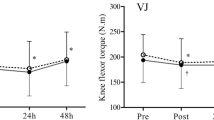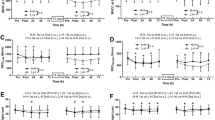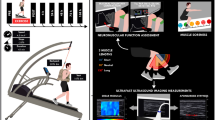Abstract
Purpose
Unaccustomed eccentric contractions generally result in a long-lasting contractile impairment, referred to as prolonged low-frequency force depression (PLFFD), and delayed-onset muscle soreness (DOMS). We here used repeated drop jumps (DJs) as an eccentric contraction model and studied the effects of increasing the time between DJs from 20 s to 5 min. We hypothesized that both PLFFD and DOMS would be less marked at the longer DJ interval due to the longer time to restore structural elements between DJs.
Methods
Young men (n = 12) randomly performed 50 DJs with either 20-s (DJ-20 s) or 5-min (DJ-5 min) rest between DJs. Voluntary, 20 Hz and 100 Hz electrically stimulated isometric knee extension torques and muscle soreness were monitored before and for 7 days after DJs; serum CK activity was measured to assess muscle fibre protein leakage. In additional experiments, changes in mRNA levels were assessed in muscle biopsies collected before and 1 h after exercise.
Results
A marked PLFFD was observed with both protocols and the extent of 20 Hz torque depression was smaller immediately and 1 day after DJ-5 min than after DJ-20 s (p < 0.05), whereas the MVC and 100 Hz torques were similarly decreased with the two protocols. Markedly larger differences between the two protocols were observed for the muscle soreness score, which 1–4 days after exercise was about two times larger with DJ-20 s than with DJ-5 min (p < 0.01).
Conclusions
The larger protective effect of the longer DJ interval against DOMS than against PLFFD indicates that their underlying mechanisms involve different structural elements.







Similar content being viewed by others
References
Agergaard J, Reitelseder S, Pedersen TG et al (2013) Myogenic, matrix, and growth factor mRNA expression in human skeletal muscle: effect of contraction intensity and feeding. Muscle Nerve 47:748–759. https://doi.org/10.1002/mus.23667
Allen DG, Lamb GD, Westerblad H (2008) Skeletal muscle fatigue: cellular mechanisms. Physiol Rev 88:287–332. https://doi.org/10.1152/physrev.00015.2007
Barclay CJ (2017) Energy demand and supply in human skeletal muscle. J Muscle Res Cell Motil 38:143–155. https://doi.org/10.1007/s10974-017-9467-7
Bosco C, Viitasalo JT, Komi PV, Luhtanen P (1982) Combined effect of elastic energy and myoelectrical potentiation during stretch-shortening cycle exercise. Acta Physiol Scand 114:557–565. https://doi.org/10.1111/j.1748-1716.1982.tb07024.x
Brown SJ, Child RB, Day SH, Donnelly AE (1997) Exercise-induced skeletal muscle damage and adaptation following repeated bouts of eccentric muscle contractions. J Sports Sci 15:215–222. https://doi.org/10.1080/026404197367498
Chaillou T, Lee JD, England JH et al (2013) Time course of gene expression during mouse skeletal muscle hypertrophy. J Appl Physiol Bethesda MD 115:1065–1074. https://doi.org/10.1152/japplphysiol.00611.2013
Chapman DW, Newton MJ, Zainuddin Z et al (2008) Work and peak torque during eccentric exercise do not predict changes in markers of muscle damage. Br J Sports Med 42:585–591. https://doi.org/10.1136/bjsm.2007.037929
Cheng AJ, Bruton JD, Lanner JT, Westerblad H (2015) Antioxidant treatments do not improve force recovery after fatiguing stimulation of mouse skeletal muscle fibres. J Physiol 593:457–472. https://doi.org/10.1113/jphysiol.2014.279398
Cheng AJ, Neyroud D, Kayser B et al (2017) Intramuscular contributions to low-frequency force potentiation induced by a high-frequency conditioning stimulation. Front Physiol 8:712. https://doi.org/10.3389/fphys.2017.00712
Cheng AJ, Chaillou T, Kamandulis S et al (2020) Carbohydrates do not accelerate force recovery after glycogen-depleting followed by high-intensity exercise in humans. Scand J Med Sci Sports 30:998–1007. https://doi.org/10.1111/sms.13655
Clarkson PM, Hubal MJ (2002) Exercise-induced muscle damage in humans. Am J Phys Med Rehabil 81:S52-69. https://doi.org/10.1097/01.PHM.0000029772.45258.43
Crameri RM, Aagaard P, Qvortrup K et al (2007) Myofibre damage in human skeletal muscle: effects of electrical stimulation versus voluntary contraction. J Physiol 583:365–380. https://doi.org/10.1113/jphysiol.2007.128827
Fridén J, Lieber RL (2001) Eccentric exercise-induced injuries to contractile and cytoskeletal muscle fibre components. Acta Physiol Scand 171:321–326. https://doi.org/10.1046/j.1365-201x.2001.00834.x
Gumucio JP, Sugg KB, Mendias CL (2015) TGF-β superfamily signaling in muscle and tendon adaptation to resistance exercise. Exerc Sport Sci Rev 43:93–99. https://doi.org/10.1249/JES.0000000000000041
Hernández-Hernández JM, García-González EG, Brun CE, Rudnicki MA (2017) The myogenic regulatory factors, determinants of muscle development, cell identity and regeneration. Semin Cell Dev Biol 72:10–18. https://doi.org/10.1016/j.semcdb.2017.11.010
Huijing PA (1999) Muscle as a collagen fiber reinforced composite: a review of force transmission in muscle and whole limb. J Biomech 32:329–345. https://doi.org/10.1016/s0021-9290(98)00186-9
Hyldahl RD, Hubal MJ (2014) Lengthening our perspective: morphological, cellular, and molecular responses to eccentric exercise. Muscle Nerve 49:155–170. https://doi.org/10.1002/mus.24077
Hyldahl RD, Nelson B, Xin L et al (2015) Extracellular matrix remodeling and its contribution to protective adaptation following lengthening contractions in human muscle. FASEB J 29:2894–2904. https://doi.org/10.1096/fj.14-266668
Jones DA, Rutherford OM, Parker DF (1989) Physiological changes in skeletal muscle as a result of strength training. Q J Exp Physiol Camb Engl 74:233–256. https://doi.org/10.1113/expphysiol.1989.sp003268
Kamandulis S, de Souza LF, Hernández A et al (2017) Prolonged force depression after mechanically demanding contractions is largely independent of Ca2+ and reactive oxygen species. FASEB J 31:4809–4820. https://doi.org/10.1096/fj.201700019R
Kamandulis S, Muanjai P, Skurvydas A et al (2019) The contribution of low-frequency fatigue to the loss of quadriceps contractile function following repeated drop jumps. Exp Physiol 104:1701–1710. https://doi.org/10.1113/EP087914
Kamandulis S, Skurvydas A, Masiulis N et al (2010) The decrease in electrically evoked force production is delayed by a previous bout of stretch-shortening cycle exercise. Acta Physiol Oxf Engl 198:91–98. https://doi.org/10.1111/j.1748-1716.2009.02041.x
Kellermayer MS, Smith SB, Bustamante C, Granzier HL (2001) Mechanical fatigue in repetitively stretched single molecules of titin. Biophys J 80:852–863. https://doi.org/10.1016/S0006-3495(01)76064-X
Kjaer M (2004) Role of extracellular matrix in adaptation of tendon and skeletal muscle to mechanical loading. Physiol Rev 84:649–698. https://doi.org/10.1152/physrev.00031.2003
Kohn S, Leichsenring K, Kuravi R et al (2021) Direct measurement of the direction-dependent mechanical behaviour of skeletal muscle extracellular matrix. Acta Biomater 122:249–262. https://doi.org/10.1016/j.actbio.2020.12.050
Koskinen SOA, Kyröläinen H, Flink R et al (2017) Human skeletal muscle type 1 fibre distribution and response of stress-sensing proteins along the titin molecule after submaximal exhaustive exercise. Histochem Cell Biol 148:545–555. https://doi.org/10.1007/s00418-017-1595-z
Kuravi R, Leichsenring K, Böl M, Ehret AE (2021) 3D finite element models from serial section histology of skeletal muscle tissue—the role of micro-architecture on mechanical behaviour. J Mech Behav Biomed Mater 113:104109. https://doi.org/10.1016/j.jmbbm.2020.104109
Lauritzen F, Paulsen G, Raastad T et al (2009) Gross ultrastructural changes and necrotic fiber segments in elbow flexor muscles after maximal voluntary eccentric action in humans. J Appl Physiol Bethesda MD 107:1923–1934. https://doi.org/10.1152/japplphysiol.00148.2009
Lehti M, Kivelä R, Komi P et al (2009) Effects of fatiguing jumping exercise on mRNA expression of titin-complex proteins and calpains. J Appl Physiol Bethesda MD 106:1419–1424. https://doi.org/10.1152/japplphysiol.90660.2008
Magistris MR, Kohler A, Pizzolato G et al (1998) Needle muscle biopsy in the investigation of neuromuscular disorders. Muscle Nerve 21:194–200. https://doi.org/10.1002/(sici)1097-4598(199802)21:2%3c194::aid-mus6%3e3.0.co;2-6
McKay BR, De Lisio M, Johnston APW et al (2009) Association of interleukin-6 signalling with the muscle stem cell response following muscle-lengthening contractions in humans. PLoS ONE 4:e6027. https://doi.org/10.1371/journal.pone.0006027
Mizumura K, Taguchi T (2016) Delayed onset muscle soreness: Involvement of neurotrophic factors. J Physiol Sci JPS 66:43–52. https://doi.org/10.1007/s12576-015-0397-0
Muanjai P, Mickevičius M, Sniečkus A et al (2019) Slow torque recovery after eccentric exercise and the repeated bout effect; the role of primary and secondary muscle damage. J Musculoskelet Neuronal Interact 19:207–214
Murase S, Terazawa E, Hirate K et al (2013) Upregulated glial cell line-derived neurotrophic factor through cyclooxygenase-2 activation in the muscle is required for mechanical hyperalgesia after exercise in rats. J Physiol 591:3035–3048. https://doi.org/10.1113/jphysiol.2012.249235
Nosaka K, Sakamoto K, Newton M, Sacco P (2001) How long does the protective effect on eccentric exercise-induced muscle damage last? Med Sci Sports Exerc 33(9):1490–1495. https://doi.org/10.1097/00005768-200109000-00011
Ørtenblad N, Westerblad H, Nielsen J (2013) Muscle glycogen stores and fatigue. J Physiol 591:4405–4413. https://doi.org/10.1113/jphysiol.2013.251629
Paulsen G, Benestad HB (2019) Muscle soreness and rhabdomyolysis. Tidsskr Den nor Laegeforening Tidsskr Prakt Med NY Raekke. https://doi.org/10.4045/tidsskr.18.0727
Paulsen G, Crameri R, Benestad HB et al (2010) Time course of leukocyte accumulation in human muscle after eccentric exercise. Med Sci Sports Exerc 42:75–85. https://doi.org/10.1249/MSS.0b013e3181ac7adb
Paulsen G, Mikkelsen UR, Raastad T, Peake JM (2012) Leucocytes, cytokines and satellite cells: what role do they play in muscle damage and regeneration following eccentric exercise? Exerc Immunol Rev 18:42–97
Peake JM, Neubauer O, Della Gatta PA, Nosaka K (2017) Muscle damage and inflammation during recovery from exercise. J Appl Physiol Bethesda MD 122:559–570. https://doi.org/10.1152/japplphysiol.00971.2016
Peake JM, Markworth JF, Cumming KT et al (2020) The Effects of cold water immersion and active recovery on molecular factors that regulate growth and remodeling of skeletal muscle after resistance exercise. Front Physiol 11:737. https://doi.org/10.3389/fphys.2020.00737
Place N, Ivarsson N, Venckunas T et al (2015) Ryanodine receptor fragmentation and sarcoplasmic reticulum Ca2+ leak after one session of high-intensity interval exercise. Proc Natl Acad Sci U S A 112:15492–15497. https://doi.org/10.1073/pnas.1507176112
Skurvydas A, Brazaitis M, Venckūnas T, Kamandulis S (2011) Predictive value of strength loss as an indicator of muscle damage across multiple drop jumps. Appl Physiol Nutr Metab 36:353–360. https://doi.org/10.1139/h11-023
Skurvydas A, Mamkus G, Kamandulis S et al (2016) Mechanisms of force depression caused by different types of physical exercise studied by direct electrical stimulation of human quadriceps muscle. Eur J Appl Physiol 116:2215–2224. https://doi.org/10.1007/s00421-016-3473-0
Umehara J, Nakamura M, Saeki J et al (2021) Acute and prolonged effects of stretching on shear modulus of the pectoralis minor muscle. J Sports Sci Med 20:17–25. https://doi.org/10.52082/jssm.2021.17
Watanabe D, Aibara C, Wada M (2019) Treatment with EUK-134 improves sarcoplasmic reticulum Ca2+ release but not myofibrillar Ca2+ sensitivity after fatiguing contraction of rat fast-twitch muscle. Am J Physiol Regul Integr Comp Physiol 316:R543–R551. https://doi.org/10.1152/ajpregu.00387.2018
Yu J-G, Carlsson L, Thornell L-E (2004) Evidence for myofibril remodeling as opposed to myofibril damage in human muscles with DOMS: an ultrastructural and immunoelectron microscopic study. Histochem Cell Biol 121:219–227. https://doi.org/10.1007/s00418-004-0625-9
Acknowledgements
We wish to thank the participants who volunteered their time.
Funding
No funding was received to assist with the preparation of this manuscript.
Author information
Authors and Affiliations
Contributions
The study was designed by SK, TV, TC, and HW. Data were collected by MM, AS, VS and TV. Data was analysed by SK, MM, AS, VS, DMR, TC, HW and TV. Data interpretation and manuscript preparation were undertaken by SK, HW, TC and TV. All authors approved the final version of the paper.
Corresponding author
Ethics declarations
Conflict of interest
The authors have no conflict of interest to declare.
Additional information
Communicated by Olivier Seynnes.
Publisher's Note
Springer Nature remains neutral with regard to jurisdictional claims in published maps and institutional affiliations.
Rights and permissions
About this article
Cite this article
Kamandulis, S., Mickevicius, M., Snieckus, A. et al. Increasing the resting time between drop jumps lessens delayed-onset muscle soreness and limits the extent of prolonged low-frequency force depression in human knee extensor muscles. Eur J Appl Physiol 122, 255–266 (2022). https://doi.org/10.1007/s00421-021-04834-x
Received:
Accepted:
Published:
Issue Date:
DOI: https://doi.org/10.1007/s00421-021-04834-x




